Earlier this year, we introduced a new dedicated plugin for resource management to create a future-proof team schedule and deliver expected results on time. In this post, we are going to show how to ditch the planning horror and go into planning–zen. .
First thing first – if you feel you need a theoretical introduction, scroll to the bottom, as we're going to jump right into the center of the topic.
How to Allocate Resources in Redmine?
Let's start with this question – what consumes a considerable part of each manager day? Planning, overseeing, and reporting. And for team members? Communication, meetings, and making plans. And then adjusting the plans to a changing situation. So how to change this?
By assigning the tasks to the right people and then the right time for their execution.
The tasks in projects come first.
To distribute the tasks in a way that's quick and easy to understand for everyone, you can use our Redmine Agile plugin. It gives you an Agile board with task cards that can be moved along the board, together with drag&drop Sprints and version planner.
Once the jobs are shared, go on to create resources bookings to share your team member's time onto tasks.
A new Redmine Resources plugin provides you with a clear understanding- Who's working on which tasks, when and for how long
- What is the availability and capacity of a team and organization level
- Where are possible narrow places in your pipeline
- How are you standing on your project realization plan
In short, you receive a management panel for managing the work schedule that's quick to use. You can add and adjust time bookings at the spot.
How to use Redmine Resources plugin?
Once the plugin is installed and activated, you will see two new elements – Resources chart and Resources widget in the My page dashboard.
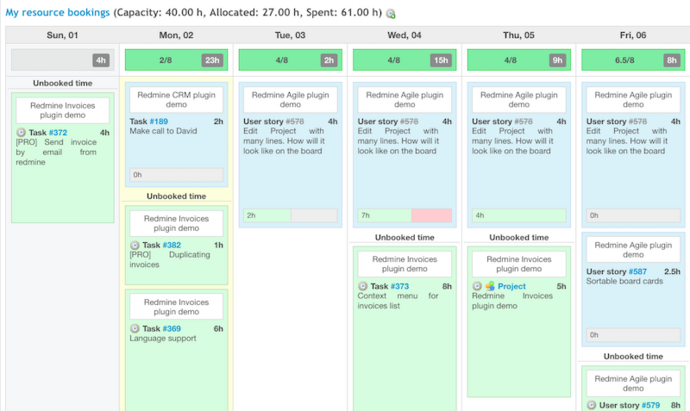
From the dashboard, you can see assigned tasks and reported time. Each task card displays a bar on its bottom. It shows how much time was booked and how much is actually reported.
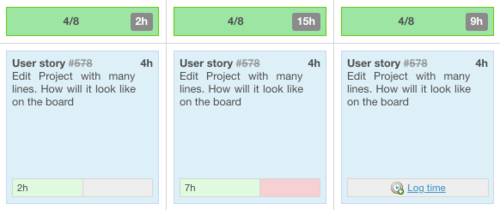
Any time that's reported outside of your booking will also be displayed there in a separate category. This widget lets you see how you stick the plan and take care of your booked time.
However, it's the charts where the work happens. On a Gantt-like time-map, you will see your employees, their tasks, and bookings. Here you can make bookings by selecting a timeframe you need – from a few hours to a few days.
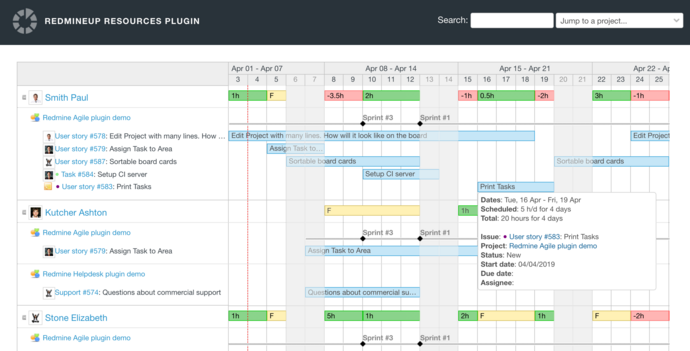
All planned release dates are visible here as well, so you can instantly see how much time you have available. The Resources plugin takes into consideration workday length and excludes weekends.
When you move the mouse over the line with the booking, you will see details along with statistics on a tooltip. Here you can click and edit the booking or drag and move the booking to re-adjust it for your needs.
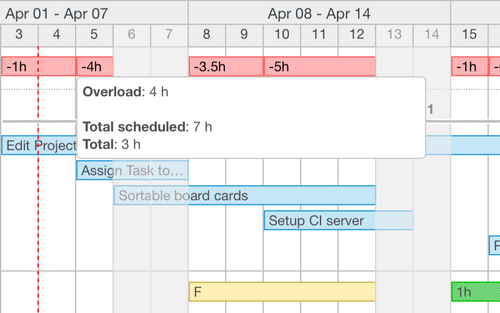
The Resource charts show all reported time spent with colors. If it's blue – no one has reported any time on the tasks. Most probably it's still waiting on its turn. If it's yellow, the time spent matches the reservation spot. If it's green – assignees are falling short on the plan. And if red – they're overworked.
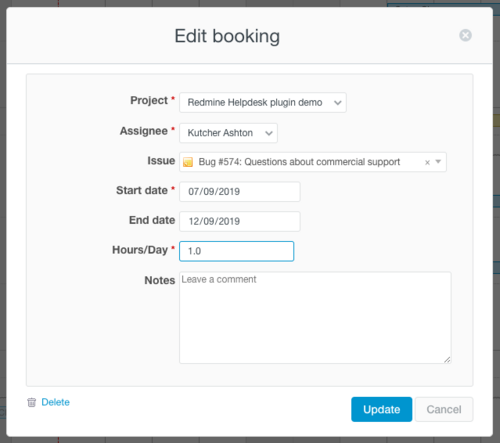
The graph is complemented by a range of configuration from filters and views to increase or decrease how much information is displayed. Also, let's not forget the smart tasks grouping and search function.
Where to see a demo or trial?
You can try the tool on our demo server by going into the Resources tab, or check the widget from My page.
If you want to test the plugin on your server, you can register for a 30–day free trial.
If you're looking for a ready-to-use Redmine, we provide a hosted solution. Our Cloud offers all RedmineUP plugins with comprehensive support and maintenance. For a fixed monthly fee, you receive access to updated continuously platform with all the benefits and free data migration from your current tool. Go on and start free 15-days trial.
What is resource management?
Each employee of your company is a resource. To correctly manage their allocation, you need a strategy and a good schedule. Especially if your projects are billed according to the "time and material" approach, you need to make sure their time is locked for the most crucial assignments. While some companies hire a traffic manager responsible for assigning people to tasks and protecting the constructed time table, others give the tools to the hands of project managers or team leaders. They are responsible for planning the time for their people and keeping an eye on the plan.



